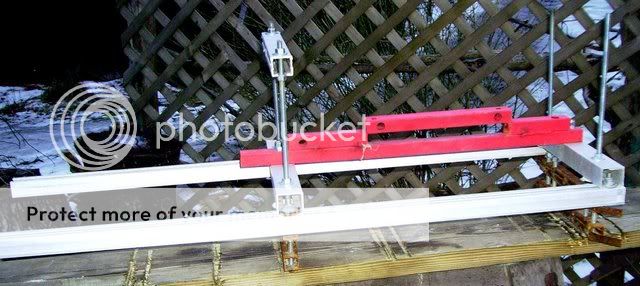So I am not good with the computer at drawing stuff up and posting it to explain my design but let me try to explain what I want to do...
I have a ps 7900 Blue dolmar, a little tuned up bought it from Cut4Fun off the forum.
I would like to attach a chainsaw mill to it to make some lumber out of some of the logs that would otherwise become firewood...
Most are smaller than 20" but I often have access to cool pieces that would make awesome slabs with the right setup...
I initially will put it onto my current 24" bar but will eventually determine how large of a bar I think this Chainsaw is good for and buy one and drill it.
I was thinking of buying one but in looking at them I think they are about a $50 to make product.. I am planning for a combo of the Granberg style with the railomatic style.
I have bought 8020 1" extrusion to make the planing deck out of.(the part that slides on top of the cant or guide) I have 2 ~6' bars of it and enough T-brackets to make a shape with 2 long pieces and 2 cross pieces (like a large "H" with two horizontal bars instead of one), all could be quickly and easily adjusted in the field. Shaped like:
_____
_|_|_
Question: What length should I go with for the long guide bars? For the cross bars?
I was initially thinking like 40" for the long guide bars and ~16" for the cross bars, but before I cut any of this what is an ideal width for the planing deck? I think I will likely go with 36" length cause I can easily buy more later and make a different sized deck for a bigger saw.
I plan to attach the frame to the saw with two 1" steel angle iron brackets spanning the top of the planing deck each sporting a plate with a square sleeve, also threaded for the all-thread height adjustment (Ala Railomatic). The verticals would be 1" square steel tube riding in sleeves (also like railomatic) with a plate on the bottom to attach to the bar by drilling the bar and bolting them directly. (with a large roller on the bottom of the bar near the power head as railomatic also has)
I plan to change on his design slightly by eliminating one crank and using a bicycle style chain to make the height adjustment acurate, parallel, and faster.
Anyway help me out here what am I missing? Besides the all-thread height adjustment what would be needed to keep the height from loosening and wandering..
What am I forgetting? I would also put on a home-made oiler to provide more oil when sawing larger items..
Please help me out here with pictures or drawings of what might help me from making my own mistakes.. I prefer to learn from others lessons!!
Anyway love this forum.. I look forward to the feedback!
I have a ps 7900 Blue dolmar, a little tuned up bought it from Cut4Fun off the forum.
I would like to attach a chainsaw mill to it to make some lumber out of some of the logs that would otherwise become firewood...
Most are smaller than 20" but I often have access to cool pieces that would make awesome slabs with the right setup...
I initially will put it onto my current 24" bar but will eventually determine how large of a bar I think this Chainsaw is good for and buy one and drill it.
I was thinking of buying one but in looking at them I think they are about a $50 to make product.. I am planning for a combo of the Granberg style with the railomatic style.
I have bought 8020 1" extrusion to make the planing deck out of.(the part that slides on top of the cant or guide) I have 2 ~6' bars of it and enough T-brackets to make a shape with 2 long pieces and 2 cross pieces (like a large "H" with two horizontal bars instead of one), all could be quickly and easily adjusted in the field. Shaped like:
_____
_|_|_
Question: What length should I go with for the long guide bars? For the cross bars?
I was initially thinking like 40" for the long guide bars and ~16" for the cross bars, but before I cut any of this what is an ideal width for the planing deck? I think I will likely go with 36" length cause I can easily buy more later and make a different sized deck for a bigger saw.
I plan to attach the frame to the saw with two 1" steel angle iron brackets spanning the top of the planing deck each sporting a plate with a square sleeve, also threaded for the all-thread height adjustment (Ala Railomatic). The verticals would be 1" square steel tube riding in sleeves (also like railomatic) with a plate on the bottom to attach to the bar by drilling the bar and bolting them directly. (with a large roller on the bottom of the bar near the power head as railomatic also has)
I plan to change on his design slightly by eliminating one crank and using a bicycle style chain to make the height adjustment acurate, parallel, and faster.
Anyway help me out here what am I missing? Besides the all-thread height adjustment what would be needed to keep the height from loosening and wandering..
What am I forgetting? I would also put on a home-made oiler to provide more oil when sawing larger items..
Please help me out here with pictures or drawings of what might help me from making my own mistakes.. I prefer to learn from others lessons!!
Anyway love this forum.. I look forward to the feedback!






